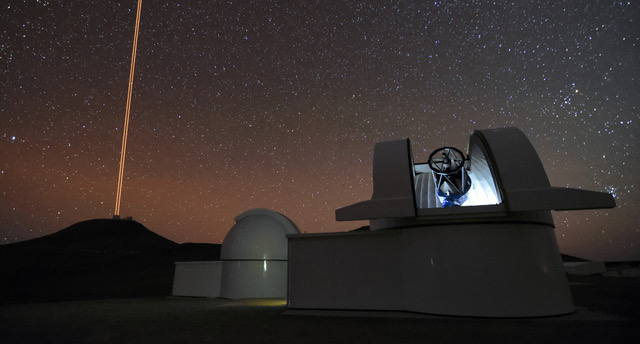SPECULOOS @ ULiège


The SPECULOOS project's main motivation is to discover potentially habitable planets well-suited for detailed atmospheric characterisation with upcoming giant telescopes, like the James Webb Space Telescope (JWST) and European Large Telescope (ELT). The project is based on a network of robotic telescopes distributed on two main observatories, SPECULOOS-South in Chile (4 telescopes) and SPECULOOS-North in Tenerife (1 telescope, soon 2), complemented by the SAINT-Ex telescopes (1 telescope in Mexico). The project was born in 2011 as a prototype on the TRAPPIST-South telescope in Chile. This prototype discovered the extraordinary planetary system TRAPPIST-1 (= SPECULOOS-1) composed of seven planets similar to the Earth in orbit around an ultra-cold dwarf star located at 40 light years. After this prototype phase, the project itself started its operations in 2019. In 2022, it discovered a new potentially habitable planet around a very-low-mass star named SPECULOOS-2 (Delrez et al. 2022). In 2024, it then found an Earth-sized planet on a very short orbit around SPECULOOS-3, an ultracool dwarf 55 light years away (Gillon et al. 2024). Many other discoveries should follow. (website)
Location Details
| Location | SPECULOOS South (SSO) @ Paranal Observatory, Chile |
|---|---|
| Coordinates | SSO: 24.61596 S 70.39057 W |
| Altitude | SSO: 2490 m |
| Location | SPECULOOS North (SNO) @ Teide Observatory, Canary Islands, Spain |
| Coordinates | SNO: 28.30000 N 16.51158 W |
| Altitude | SNO: 2438 m |
| Type | Ritchey-Chrétien F/8 with 2 lenses corrector. German Equatorial Mount (with no meridian flip). |
| Size | Primary M1: 1-meter ; Secondary M2: 0.286-m |
| Operated by | SPECULOOS is a project led by the University of Liege (project leader: Michaël Gillon) and carried out in partnership with the University of Cambridge, the University of Birmingham, the Massachusetts Institute of Technology, the University of Bern, and the University of Zurich. |
| Instruments | 2Kx2K deeply-depleted CCD camera (Andor Ikon-L 936 BEX2-DD) |
Telescope Time
Time available through agreement with the Director. You can send your proposal to Michael Gillon (project leader) with copy to Amaury Triaud (deputy director) and Sebastián Zúñiga-Fernández (Observatory manager).
Observing Cycles
Observing time availability will be evaluated case by case by the director and the PIs of the project.
2Kx2K deeply-depleted CCD camera (Andor Ikon-L 936 BEX2-DD)
- Detector: CCD
- Field-of-view (Size and shape): CCD camera’s pixel size is 13.5 microns, translating into a pixel scale of 0.35”/pixel and a total field of view of 12’ x 12’.
- Read-out time: The read-out + overhead time is ~10s
- Wavelength range: quantum efficiency above 85% from 400 to 850nm.
- Each camera is operated at -60°C with a dark current of ~0.1 el/s/pixel. Its window is optimized for the visible/near-IR and blocks all wavelengths below ~400nm (Fig. 2). Its gain is about 1el/ADU, and it is linear over its whole dynamical range. The read-out + overhead time is ~10s. The camera is coupled to a filter wheel equipped with the Sloan g’, r’, i’, and z’ filters, and special filters “I + z” (transmittance >90% from 750 nm to beyond 1000 nm) and “blue-blocking” (transmittance >90% from 500 nm to beyond 1000 nm).